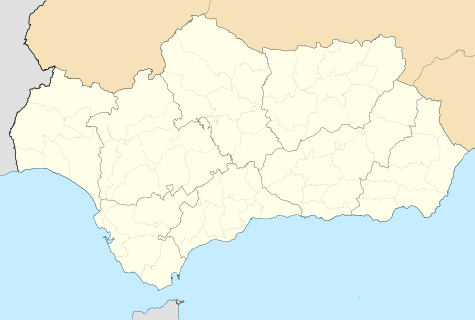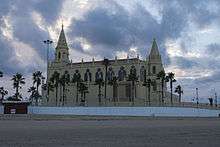Chipiona
| Chipiona | ||
|---|---|---|
| Municipality | ||
|
Coast of Chipiona with the lighthouse at background | ||
| ||
.png) Location of Chipiona | ||
 Chipiona Location in Andalusia | ||
| Coordinates: 36°44′N 6°26′W / 36.733°N 6.433°WCoordinates: 36°44′N 6°26′W / 36.733°N 6.433°W | ||
| Country |
| |
| Autonomous community |
| |
| Province | Cádiz | |
| Comarca | Bajo Guadalquivir | |
| Commonwealth | Municipios del Bajo Guadalquivir | |
| Government | ||
| • Alcalde | Antonio Peña Izquierdo | |
| Area | ||
| • Total | 32.92 km2 (12.71 sq mi) | |
| Elevation | 4 m (13 ft) | |
| Population (2012) | ||
| • Total | 18,849 | |
| • Density | 570/km2 (1,500/sq mi) | |
| Demonym(s) | Chipionero, ra | |
| Time zone | CET (UTC+1) | |
| • Summer (DST) | CEST (UTC+2) | |
| Postal code | 11550 | |
| Website | Official website | |

Chipiona is a town and municipality located on the Atlantic coast in the province of Cádiz, Spain. According to the 2012 census, the city has a population of 18,849 inhabitants, but this amount increases greatly during the summer holiday period. The town covers an area of 33 km². Being in the lower valley of the River Guadalquivir it is very flat with a maximum terrestrial height of 4 metres. It is bordered on the north-west by Sanlúcar de Barrameda and on the south-east by the port of Rota.
It is the town of birth of singer Rocío Jurado and where her body now rests.
Chipiona is also home to the tallest lighthouse in Spain and the third tallest lighthouse in Europe. The town is also well known for several varieties of Moscatel.
Places of Interest
- The Chipiona lighthouse is the most emblematic monument of the town. It is the largest lighthouse in Spain, the 3rd in Europe and the 5th in the world. Its height from the base is about 69 meters, dates from 1867 and is located in the Punta del Perro. It was built to prevent the ships having problems accessing the river Guadalquivir and colliding with the Salmedina Stone.
- The Marina: early 90s took out the construction of the Marina, located near the mouth of the Guadalquivir, in 2008 is subjected to a process of enlargement.
- The Shrine of Our Lady of Regla: The current building of the shrine dates from the early twentieth century, built by the Franciscan missionary community, with the help of the Duke of Montpensier. It originated in an ancient castle fortress of a fourteenth century family (pripiedad Ponce de Leon), who donated it to the hermits of St. Augustine in 1399 to convert it into a church.
- Castle Chipiona: houses the "Cadiz and the New World" museum.
- Muscat Museum: Opened in 2012. Located in the Cooperative Agricultural Catholic.
History
Antiquity
According to the geographers Strabo (Strabo, III, 1, 9) Pomponius Mela (Mela III, 4), of Ancient Greece and Rome, respectively, a lighthouse existed at the mouth of the Guadalquivir River called Turris Caepionis. This was probably because it was built to instances of the Roman Consul Quintus Servilius Caepion or some of their descendants. The tower acted as a warning for a dangerous place of navigation, and also marked the opening of a navigable river, the Guadalquivir. Traditionally seen in the name of this lighthouse was the name of Chipiona.
This area is further identified as the area in which stood the legendary Ars Gerionis, which was the tomb of Geryon, that stood at the end of a narrow cape that jutted into the sea probably in what is now a reef known as the Stone of Salmedina under Salmedina, or just Salmedina. In all of this there is no more evidence than that of the literature and Roman archaeological findings dating from the second century B.C.
Middle Ages
Legend relates that the disciples of St. Augustine in Africa, fleeing the invasion of the Vandals, came by sea to Chipiona with the image of the Virgin of Regla. Tombstones have been found near the Shrine of Our Lady of Regla from the time of the Visigoths. After the Islamization of the Iberian Peninsula in 711, following tradition, the hermits hid the image in a cistern about thirty paces from the citadel, now a monastery. The picture remained hidden until S. XIV in a religious of the Order of St. Augustine found, through a revelation from heaven. About the cistern was built a Shrine of Our Lady of Regla.
In 1251, Chipiona was conquered by King Ferdinand III, turning to reconquer it indefinitely in 1264 by his son Alfonso X the Wise. In 1297, King Ferdinand IV granted Guzman el Bueno, founder of the House of Medina Sidonia, the Lordship of Sanlúcar, of which Chipiona belonged.
In 1303, the eldest daughter of Guzman el Bueno and Maria Alonso Coronel, Isabel Perez de Guzman, Fernan married Ponce de León, receiving as a dowry the towns of Rota and Chipiona, becoming independent both of the Lordship of Sanlúcar and joining the possessions of the family Ponce de León, germ Arcos House.
Modern Age
In 1755, Chipiona was severely hit by the tsunami that was caused by the Andalusian and Portuguese Atlantic coast Lisbon Earthquake. The effects of the tsunami came to town about an hour after the earthquake, killing four people and leaving flooded streets and beaches, estimating the actual damage to 238 815.
He pulled in procession the image of Christ of Mercy to request the withdrawal of the waters, procession that is repeated every year on November, from the chapel that bears the name of Christ to the Cross the Sea
Earthquake Narration by the Community of the Holy Convent of Nuestra Señora Santa María de Regla, on December 6, 1755
In the aforementioned November 1 was not noticed any news from sunrise until 10 day time to be serene, and peaceful day, still and calm sea, North Wind insensitive. But, being as 10am, being this Community as high choir solemnly singing the third hour, she began to feel that the choir, and the church with strange swaying motion and this, as noticeable in the view, that lectern, church lamps, candlesticks from the altar, and all the temple shook and moved to a crib mode, from one side to another side, looking to the North and South.
Advirtióse be a terrible earthquake, and although all the relevant cause fright, and entered the desplomase suspicion that the whole building, which [is] of stone, over us all, lacked the freedom to forsake the choir, tied up all of one impulse, and full of confidence safer Patronage of Our Holy Image, which was patent to the eye in its majestic throne. At the point we bow all knees, and straining our devotion, we continue with the canonical time more consistently.
It would last the tremor as ten to twelve minutes, knowing the land restitution made her pause, and natural stillness, came the Community to take their seats, each recognizing the Divine Mercy, and the patronage of Our Lady of Rule, Our Lady, we escaped the threatening havoc with such happiness that is not the least harm experienced in all areas of the convent.
Cantóse conventual Mass without the least suspicion, and concluded, was sung the sixth hour on the end of it, it would be like the 11 and fourth, there was a terrible roar of the sea, and found to be elevated both waves, violently throwing water on said bastion, and on the cliffs of the convent, were overwhelmed by a gunner, who was in it (which did not suffer any damage, having invoked the patronage of Our Holy Image) , and fell upon the walls of the convent, and running for their flooded trenches surrounded the Church and its 2 sides to enter through the front door of the Farm, looking to the East.
Surprised by this unanticipated boost the ocean, some religious who were outside, and within the choir, acceleration fled to the fields, keeping others in the same choir.
Demographics
Source: INE (Spain)
| 1999 | 2000 | 2001 | 2002 | 2003 | 2004 | 2005 | 2006 |
|---|---|---|---|---|---|---|---|
| 16,200 | 16,539 | 16,814 | 17,127 | 17,334 | 17,603 | 17,730 | 17,952 |
Festivities and traditions
- Carnival: Celebration of long tradition in the municipality, the documented reference to the carnival in Chipiona, oldest is an 1896 City Council Edict, which regulates the operation of these parties and that their existence is clear earlier era . Franco during the carnival celebrations were banned in Spain. In 1984, was restored and since then this festival is held annually between the months of February and March. The closure takes place with the parade, fiesta known regional interest.
- Easter: Chipiona has two penitential brotherhoods: the Sisterhood and Brotherhood of Our Father Jesus Nazarene Captive, dating from 1960. The Virgin of Sorrows is eighteenth-century anonymous work. The Brotherhood of Penitence ago on the day of Holy Thursday.
Brotherhood. Christ of Mercy. Penitence ago in the day on Friday. The image of Christ of Mercy has great popular support from the Earthquake of Lisbon, in November 1755, in which he took the image of Christ in supplication. This event is reminiscent of the November 1 of each year, as they draw the Christ of Mercy in a procession of thanksgiving. In 2006, the Brotherhood joined the image of Our Lady of Mercy.
- Pinar Pilgrimage: Pilgrimage to be held the first Sunday of June in the Pinar de la Villa, in which the Virgin of Regla del Pinar, after transferring prior three days prior to the Shrine of Our Lady of Regla, returns to its pine accompanied by horsemen, carts and the general public.
- Virgin of Carmen: The patron saint of sailors out of his feast day on 16 July, being shipped at noon and paraded through the seas of the Villa. During the afternoon a procession through the main streets of the town ending with a fireworks display on the beach of the Sea Cross.
- Evening Rule: They are dedicated to Our Lady of Regla and celebrated at the Shrine of Our Lady of Regla. Culminate with the release of Our Lady of Regla on September 8 and end with a fireworks display on the beach Rule.
- Halloween and Feast of All Saints: It is increasingly frequent in the evening of October 31 children out dressed as monsters and spooky to the streets to ask for candy door to door. On November 1, Feast of All Saints, takes place Thanksgiving procession of the Holy Christ of Mercy, due to the miracle performed in Lisbon tsunami.
- Christmas: The city is decorated with Christmas lights. In 2003 formed the Association of Bethlehem "Caepionis" which made many activities, such as cribs courses, conducting Cartel Christmas, a live nativity scene, Bethlehem contest or the Proclamation of Christmas. Zambobás are traditional organized by the different neighborhoods and village associations. On the afternoon of January 5 takes the Three Majesties Kings of the East, which since 2009 is the Child worship of God in the Plaza Pio XII.
See also
References
External links
| Wikimedia Commons has media related to Chipiona. |
- Ayuntamiento de Chipiona
- Sistema de Información Multiterritorial de Andalucía: Chipiona
- Patrimonio cultural de Chipiona en la base de datos del Patrimonio Inmueble de Andalucía. Instituto Andaluz del Patrimonio Histórico
- Guía de turismo de Chipiona
- Fotos de Chipiona
